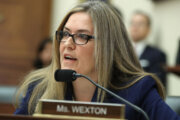WASHINGTON — During the Cold War, a widely held U.S. intelligence view of Soviet troops was, “easy to find, hard to kill.” But today’s view of the Islamic State, arguably the greatest threat to U.S. national security since then, is exactly the opposite –“easy to kill, hard to find.”
Former National Security Agency (NSA) and Central Intelligence Agency (CIA) director Michael V. Hayden coined both phrases, and indicated the expiration of key U.S. government authorities to track terrorists is not helpful with the problem of finding ISIL.
“Giving up, unilaterally, intelligence capabilities are the same thing as unilateral disarmament at the height of the Cold War,” said Hayden.
“That’s why it’s so irresponsible for one senator to prevent action to extend and reform three key counterterrorism tools for his own political gain. Holding critical national security programs hostage to raise political donations is outrageous, but that’s where we stand today,” said California Sen. Dianne Feinstein, in a statement.
Kentucky Republican Sen. Rand Paul prevented Senate Majority Leader Mitch McConnell, a fellow Republican and Kentuckian, from facilitating a vote on several provisions of the Patriot Act, allowing the authorities to expire.
The three programs that have been sidelined are:
- The Section 215 bulk Collection Authority or the business records provision, which allows investigators to access who terrorists talk to on the telephone, and key information about their activities including hotel, rental car records and credit card statements.
- The Roving Wiretap prevents the disruption surveillance, even when an individual acquires, uses and discards numerous communication devices or email addresses to prevent tracking. This provision allows investigators to collect data on an individual rather than a specific telephone or email address.
- The Lone Wolf provision allows the government to collect intelligence on known or suspected terrorists for whom the government cannot yet demonstrate an affiliation with a specific terrorist group.
Before the swift rise of ISIL approximately a year ago, al-Qaida was seen by intelligence officials as the world’s most dangerous terror group. A large part of the concern, according to U.S. intelligence sources, was the difficulty finding them.
But even with tens of thousands of fighters, operating out in the open and the occupation of large swathes of territory, “ISIL is in the same boat as al-Qaida,” said Hayden.
“They’re a little easier to find, because they leave such a digital exhaust out there in the cyber domain. But, nonetheless, they are still easy to kill, but hard to find, which makes this an intelligence based war — just as with al-Qaida.”
Intelligence officials from numerous countries have acknowledged that thousands of individuals from all over the world have been joining ISIL’s ranks. Many of them are believed to have been trained and melted away, possibly returning to their home countries.
While Hayden believes that process makes it harder to find and eliminate the threat they pose, he says, “It’s not just their size, it’s their approach.”
He calls Al Qaida an “elitist terrorist organization. Things were controlled from the top and then trickled down in the way of directives or couriers or messages to agents in the field.”
But according to Hayden, “ISIS is far more populist. They’re far happier with things bubbling up from below. So the things we used to rely on to stop al-Qaida attacks — the people, the money, and the communications. Frankly I think it would much harder to do with ISIS.”
Senior U.S. government officials say the sheer numbers of ISIL recruits, their use of modern technology to communicate, plan, conceal and execute their schemes is difficult enough. But without important counterterrorism tools, detecting their plots as they bubble up is much more difficult.





